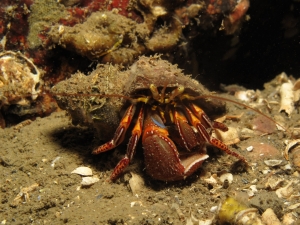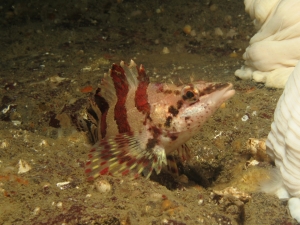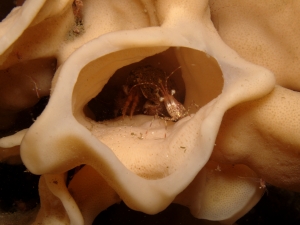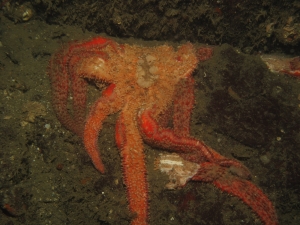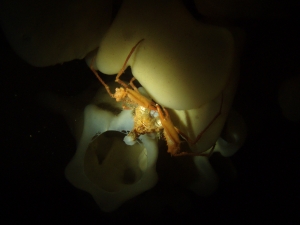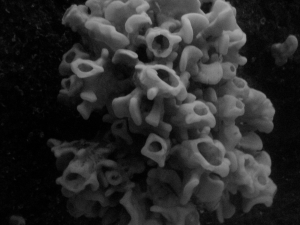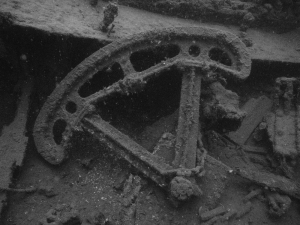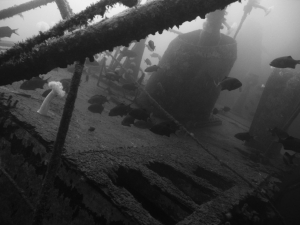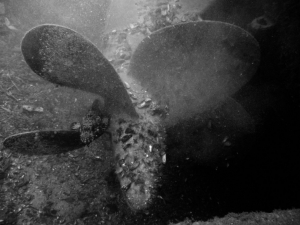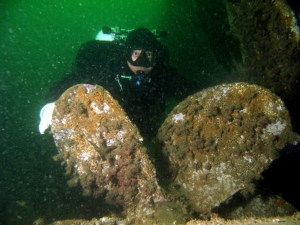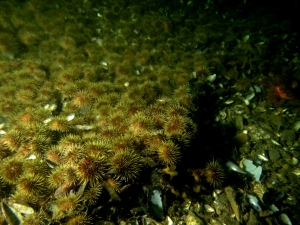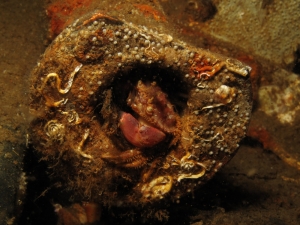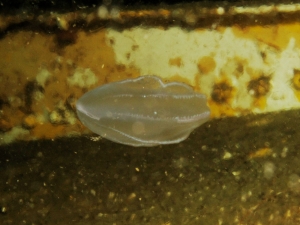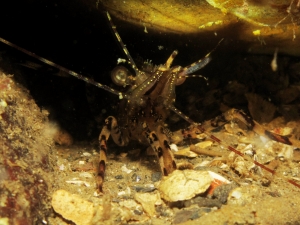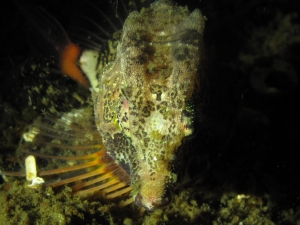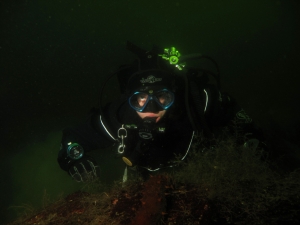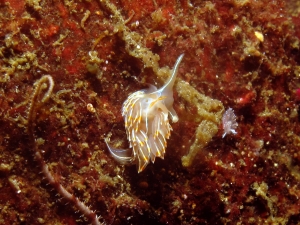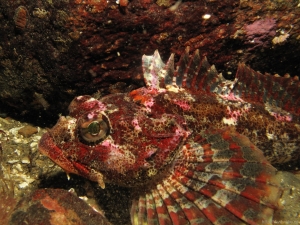In case you were wondering what the guts of an Apeks DS4 look like…
Latest Entries »
Cold water diving necessitates thick insulation, which in turn requires a lot of weight to sink. With a steel tank, 5kg steel backplate and another 6kg of lead, I decided I needed more weight on my back, so I switched to doubles. Luckily the rigging for doubles is heavy enough to allow losing some of the lead ballast, but the entire rig is still rather heavy on the surface.
In the water, the doubles were a dream — They trimmed out well, and I didn’t have to fight them. After a sloppy valve drill (need to work on that) I felt comfortable enough to carry on with the dive and start taking photos.
The next step is to polish my skills and upgrade to a Fundies Tech pass…
Just one long dive today, starting in the bay then heading out to the plumose gardens. There was a touch of current out in the gardens due to the large interchange, but it was a good dive regardless. Plenty of rockfish, squat lobsters, hermit crabs, nudibranchs of various types and the other usual suspects. I managed to snap some photos I’m happy with today.
We found a cool glass sponge at about 22 meters as well. One thing I love about glass sponges is that it provides hiding places for so many small critters, and it’s a lot of fun to peek into all the nooks and crannies to see what you’ll find.
The Starfish die-off was still very evident today, and I’ve documented that in a separate post.
After we had thumbed the dive, on the ascent I found a Grunt Sculpin peaking out from a giant barnacle, the perfect photo opportunity. Unfortunately a thumbed dive is a thumbed dive, and with my camera stowed I couldn’t get a photo. It looked like there was a lot of interesting things in that area (near the rocks by the day marker) so I’ll have to go back sometime and look for photo opportunities.
In an earlier blog post, I’d mentioned that we had observed a large amount of dead starfish out at the Cut at Whytecliff, which was corroborated by a news story about a mass starfish die-off. Diving at Whytecliff again today, again we noticed pieces of starfish at around 10 meter depth on the right wall (although not quite as concentrated as they were at the cut last week). It appears to have hit only a couple species of starfish (Morning Sun Stars?), although I didn’t notice too many of the other usual suspects in the area apart from a healthy-looking slime star at depth.
The decomposition (disintegration?) appears to have greatly progressed into a grey-slime kind of state, although to be honest the grey-slime may be completely unrelated. I’m not entirely sure. Interestingly there appeared to have been some dead crabs in the area as well. I didn’t check to see if it was simply the case that the a couple of crabs had moulted in the decomposition pile, or if they were actually dead crabs.
A quick video clip (with horrible white-balancing) of an area saturated with the grey slime, and some photos of the carnage are below for documentation purposes. If any marine biologists happen to be reading this, I would appreciate an expert weigh-in in the comments below.
Another dive site I’ve somehow neglected since moving out here has been “The Cut” at Whytecliff. So, in good measure Josh and I decided to go dive it. The Cut itself is a fun dive site, with an interesting descent that ultimately leads incredibly deep. We stopped at 30 meters and went to see the glass sponges that are one of the signatures of the Cut. Unfortunately the fiber optic to sync my stobe was loose and my strobe wouldn’t fire on the first dive. I managed a couple of photos using my can light to illuminate, but nothing special.
The Glass Sponges are really interesting. Very intricately shaped, with lots of good hiding spots for critters. There was one with a false lobster hanging out which would have made a fantastic photo. Definitely a spot worth checking out.
Our second dive we decided to swim from the cut into the bay. A bit of current worked against us so I didn’t take too many photos in the anenome garden. Again, not too many great photos out of this dive, but the dive itself was great, especially exploring the bay which seemed to be full of Frosted Nudibranchs. I even saw a yellow and white-tipped Nudi, but unfortunately the photo didn’t turn out well. The dive was capped off with some drills and a very smooth free-water ascent.
Interestingly, the shallows around the cut seemed to be full of dead, half disintegrated starfish. This was rather unusual. Later in the week after the dive some news articles started popping up about the mysterious die-off: “Massive Starfish Die-Off Baffles Scientists“. I’m curious if this is a natural phenomenon (Population surge, disease, etc.) or something related to humans (pollution, etc). I didn’t get any photos of the dead starfish at the time, because to be honest it wasn’t the most photogenic subject. I’ll try and get some shots to document it next time I’m out. In the meantime, the link I posted above has some shots of the phenomenon. Also some tin-foil-hat worthy comments in the comments section….
Some photos from the dive below the jump..
Somehow, having been in Vancouver for three and a half years, I’ve managed to never dive the Nakaya at Porteau Cove. I think the lengthy surface swim has something to do with it.
Disregarding my intense dislike for long, if any, surface swims, we made our way out to the Nakaya to start off a dive. After a quick search, she rose out of the darkness and there we were.
My first impression of the Nakaya was that it looks like a real wreck — It has definitely been down for a while. Very cool, though, and I’m anxious to visit it again. I think it will be a great place to take wreck photos in the winter when the viz clears up. In the meantime I have some miscellaneous photos of the unidentifiable mess.
The usual suspects were at Porteau, so and I snapped some photos of them too. One thing that never ceases to amaze me is the camouflage displayed by the various critters out on the west coast. While warm water reefs are known for flashy coloured fish (Although they have their own well-hidden residents), a lot of the animals here rely on camouflage to stay hidden from predators. The photo on the right is a fantastic example. I think I’ll have to work on lighting techniques with the strobe to try and cast more of a shadow on these guys to bring them out a lot better.
Originally intending to dive at Furry Creek today, Josh and I drove out to Oliver’s Landing to scope out the conditions. After seeing the very low tide with a long, rocky entry, and the tens of people fishing along the shore, we decided to drive out to Britannia Beach and dive the wrecks out there instead.
The low tide had cleared out some of the silt, and below the first few meters of literally zero viz, the visibility opened up to nearly 5 meters or so, and a bit more deeper. The second dive was a different story, as the incoming tide brought back a lot of the sediments near the wreck. Our second dive’s descent out in the bay was perhaps one of the most fun descents I’ve done recently, where we sank through seemingly over five meters of chalk-like water where we had to maintain physical contact so as to not become separated. All of a sudden, everything turned dark and the visibility opened up to over five meters, but was nearly pitch-black. We headed down to 20 or so meters where it seemed to bottom out but there was nothing see but sand and pricklebacks, so we hooked back to the shallow recks.
Having not been out there in over a year, it was interesting to see the changes that have occurred. The wooden fishing vessel butted up against the CCGS Ready had decayed somewhat since I last visited. The radar mast had fallen over, increasing the amount of clutter on the west side of the wrecks. The superstructure in general looks like it had collapsed in upon itself, with the funnel lying on the ground when it had still been firmly attached to the top of the superstructure in February 2012.
The CCGS ready is still as in-tact as it was a year ago, but there is an increased amount of life growing on the wreck itself. A great comparison photo (in-spite of the atrocious viz) is the propeller, which had nearly no life on it last year.
The photo above on the right is a good demonstration of how useful it would be to have a second strobe. I had the one strobe all the way out to the left, but had to angle it in a bit to get everything illuminated. You can see the atrocious backscatter on the left side of that photo, and how it’s not quite as bad on the right. If I had two strobes, one way out to each side and both angled out, I could illuminate everything well without quite as much back-scatter in silty conditions like this.
Some interesting notes about the life in the area, was the huge number of sea urchins, which in some places were gathered in groups of what must have been over a hundred individuals. I’m not sure what causes this kind of clustering, or if it’s natural/healthy/normal or not. I’d have to defer that to biologist familiar with urchins.
Plenty of squat lobsters and shrimp in the area, as usual. Since they’re so easy to photograph (Since they don’t run away readily!) so a lot of photos of those. Not too many other photos that really stand out this time around.
Also of interest were the hundreds of dungeoness (?) crabs living at the three to six meter zone between the wrecks and our entry point. There were so many crabs scuttling away from us that they stirred up enough silt to severely reduce the visibility; It was almost as bad as an open water class ;). A quick video below:
The rest of the photos from today are below the jump:
Getting my camera ready for some diving tomorrow, and flipping through photos to delete to clear up some space on my SD card, I was shocked to find some photos I didn’t remember processing. Double-checking my log book and this blog, I realized they were photos from Britannia Beach from quite a while ago, May 20th 2012 to be exact.
I’m not sure why I never got around to editing and uploading these photos. Not too many great ones, but the photos on the left is pretty memorable. I remember (from reviewing all the shots that didn’t turn out!) how awkward it was to try to light him up properly for a good shot.
The photo of the funny looking Jellyfish on the right turned out quite well, however doesn’t truly reflect how amazing these little creatures are. They white lines are on their body are actually rows of scilia that give off an interesting iridescent effect if you pay close attention. It also reminds me of something out of Star Trek…. The ocean is full of interesting creatures.
As usual, more photos below.
This August long weekend I found myself at Porteau cove again, much like last year. (Here’s hoping that this year it doesn’t start off a far too long dry-spell again). The tide was very low and the visibility wasn’t the best with plenty of turbidity and sediment in the water, but I it was a fun dive nonetheless.
I didn’t get any especially great photos this time around as I wasn’t quite in the photo-zone. But, such is the life of an amateur under-water camera type person. (I refuse to call myself a photographer, hah!). Sometimes you get some fantastic photos, sometimes you don’t. All the more reason to do some more diving and try for some great shots next time.
Interestingly, while doing an S-drill I managed to clip off my camera leash around can-light cord, causing some issues with deploying my long hose. There is no standard GUE/DIR way to clip off a camera, and I’ve evolved my current setup over several iterations. I have two bolt snaps on my camera. One tied right to the tray so that I can clip the camera off close to me when not in use, and another attached to a short bungee leash so the camera is always secured to me, allowing me to easily drop it in an emergency). One of the many great reasons why doing regular S-drills is a good idea, as it helps you catch kinks. In this case, it’s a great reminder to pay attention when I’m clipping off my camera to ensure I don’t trap my can light cord.
The dive itself was fun as always. The low clouds against the mountains are always amazing to see while swimming out over calm water. Shore diving on the West Coast truly is amazing.
Full gallery is below.
After a long few weeks of moving and business travel keeping me out of the water, Josh and I hopped on the early ferry this morning for a couple of rewarding dives up in Tuwanek. The weather was fantastic, and the viz down below 15 meters was epic. It must have opened up more than 20 meters in visibility. As always, lots of life to see in Tuwanek, which is why it truly is one of the local gems.
Unfortunately, however, I had to do this dive without a strobe on my camera. While doing some equipment checks last night, I discovered my strobe wasn’t working. This is the second time I’ve had strobe issues at Tuwanek. Of course, I have the internal camera flash completely masked off in my case, so it was of no use this time around. (The internal flash triggers my external strobe, however to avoid back scatter the internal flash needs to be fully masked off). Not to be deterred, I decided to bring the camera along anyways and try taking some ambient light photos anyways. I figured I could even use my newly upgraded LED can light to illuminate some things too.
Was it ever worth it!
Although I didn’t manage a lot of great shots, I did get some okay shots. I also managed to get the above shot of an Red Gilled Nudibranch*. For this shot, I used my LED canlight to side-illuminate the nudibranch. It produced a rather nice effect focusing light and attention on the Nudi, almost like a snoot. This has to be one of my favorite nudibranch photos I’ve taken so far.
Shortly later, I saw a Grunt Scuplin, which have to me my favorite type of scuplin. Something about their colouring, shape, and the way they sort of hop around makes them interesting to watch and look at. I only had one chance to take a photo, as right after it decided it no longer wanted to be party to photo taking and turned around to face a rock. Regardless, I got a fun picture, again using my can light to illuminate the fish from the side. It could have turned out better, but I like it regardless.
Early into our second dive, Josh got my attention and pointed out a swimming giant nudibranch! I tried taking a video, but it had stopped swimming by the time I got the camera set up. Some photos are in the gallery at the bottom of this post.
The amazing thing about Tuwanek is just how much life is packed into the area. It truly is like diving in a fishtank. The small tides, sheltered conditions, amazing visibility and warm water temperatures all combine to make it one of my favorite BC dive sites. The Sunshine Coast in general is fantastic as well. At least the ferry ride is relatively quick to get out there for day-trips!
I don’t have a RAW editor installed at the moment, so I’ve only tried touching up a few of the ambient light photos. My camera doesn’t have the best low light performance, but I got some interesting shots anyways. Perhaps later I may fiddle with processing some more of the RAW images to see if any are worth recovering and posting.
The rest of the photos I have processed are below;
*Note: I initially miss-ID’d this as an Opalescent Nudibranch (Hence the jpg filename). Upon checking my handy reference book, it is in fact a Red Gilled Nudibranch.
My lovely dive partner and I had the opportunity to spend a night with family up in the Sechelt Inlet, at a beach house Steffy’s parents had rented south of Tuwanek. (Luckily the Ferrets were feeling much better after their bout of illness on the weekend, otherwise we would have had to cancel on this short but fun trip!)
The beach house had a dock, which made for an easy giant-stride entry right from where we set up and put on our gear. Quite a treat compared to huffing gear all the way down to the water at Whytecliff.
A lot of new stuff in this dive, including my upgraded dive-light (which worked amazingly), my new Heser backplate, simple fleece undergarments instead of my thick Mk3 (The water was very warm) and the first time taking my camera out in nearly a year! It took a bit of shaking out, but we got a couple of great dives in. The Viz below the first few meters was incredible, as always in the Sechelt inlet.
Unfortunately, my camera got bumped on sometime during the trip out and the battery was nearly dead by the time we got into the water. Nonetheless, I got a few nice shots. Not some of my greatest photos, but not bad for being out of practice with the camera!
The new dive light worked phenomenally well, but in some of my photos I realised I had developed a bad habbit. Since the old HID had been fairly dim in comparison, I used it as an aiming light. Usually I’d point it away as I released the shutter, but sometimes would leave it since it barely effected my photos. Not so much with the bright LED. You can clearly see my little mistake with the Grunt Scuplin photo. I think it’s time to invest in a proper focus light.
The Heser plate was amazing as well, being able to do away with the weight belt completely with lighter insulation was very liberating. I don’t think I’ve ever felt so free while cold water diving!
I borrowed Steff’s Dad’s GoPro camera for the dive and had it mounted on my goodman handle, but unfortunately the video seems to have become corrupted. I’m trying to recover it, and if I’m successful I’ll post a video in the coming days.
A few more pictures below:


